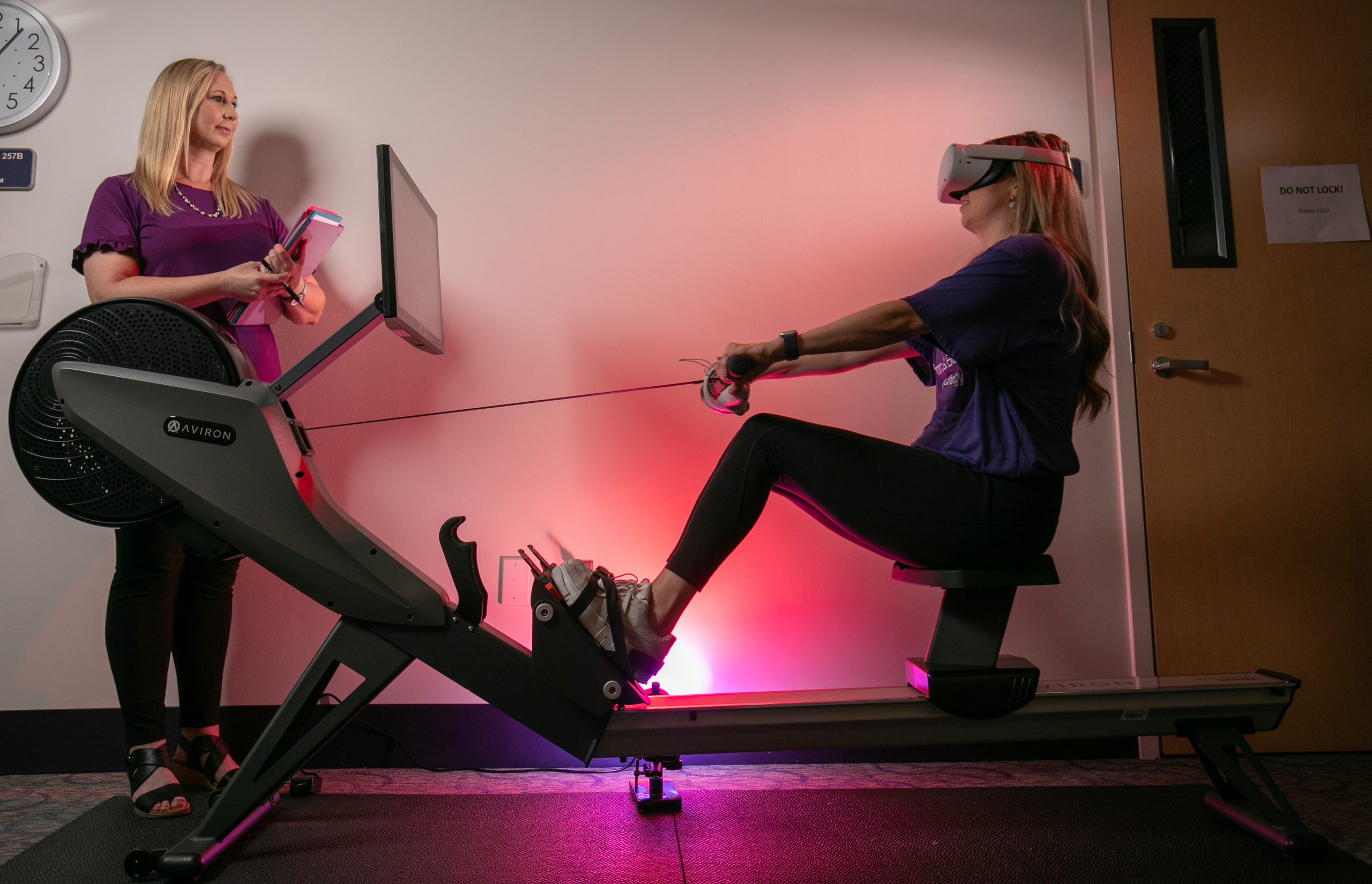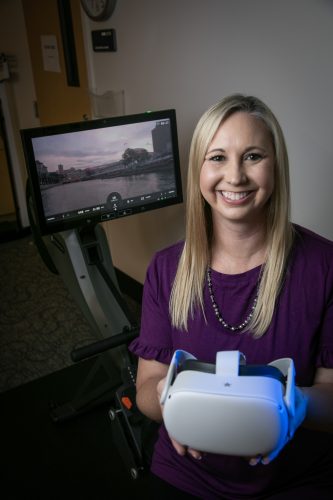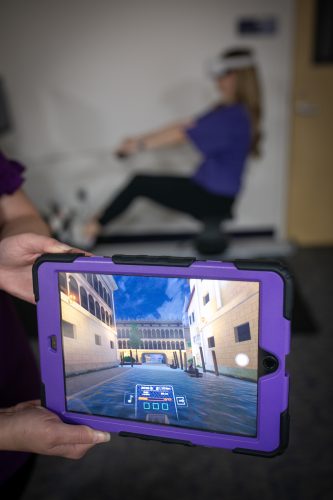Immersed in Exercise
Kinesiologist Robyn Trocchio turns to virtual reality to help people have fun getting fit.

Robyn Trocchio, left, and Sarah Junkersfeld study the potential of full-immersion virtual reality to improve a person’s motivation to exercise. Photo by Rodger Mallison
Immersed in Exercise
Kinesiologist Robyn Trocchio turns to virtual reality to help people have fun getting fit.
THE U.S. CENTERS FOR DISEASE CONTROL AND PREVENTION RECOMMENDS that adults work out five times a week for 30 minutes per session or complete 75 minutes of rigorous activity per week.
Mothers, fathers, coaches and doctors have been telling people for years about the importance of exercise, and with good reason.
Studies show that working out helps with both physical and mental well-being.
But the thought of hitting the gym can also lead to excuses to not do it.
“I just don’t have the time.” “It’s too hot/cold outside.”
“I sneezed a few days ago.”
Behind every excuse to skip exercise is one basic reason: Many people find repetitive physical activity to be no fun.

Robyn Trocchio, associate professor of kinesiology, holds a virtual reality headset she has incorporated into her research on making exercise more enjoyable. Photo by Rodger Mallison
“A lot of individuals come in with this bias that exercise is intense, it’s not an enjoyable activity, that we’re already coming in thinking, ‘This is going to be terrible,’ ” said Robyn Trocchio, associate professor of kinesiology at TCU’s Harris College of Nursing & Health Sciences. “If we have those thoughts, how’s it going to be?”
People understand the importance of working out, Trocchio said. But that doesn’t always translate into action. A 2021 report from Trust for America’s Health found that 61 percent of U.S. adults gained weight during the pandemic. A Journal of Global Health study published in 2022 found that Covid-19 led to “significant decreases in mobility, walking and physical activity, and increases in sedentary activity.”
Trocchio and Sarah Junkersfeld, a PhD student in health sciences, are working to help reverse the trends.
They completed a 2022-23 study that tracked 30 TCU students who worked out while using full-immersion virtual reality. Rather than staring at a gym wall or pounding the pavement in their neighborhood, the participants sat in a rowboat and, by the end of the study, steered it over a virtual river. They attended three sessions over one week.
The results were encouraging enough that Trocchio and Junkersfeld submitted the paper to a research journal and are considering undertaking an additional study that will track participants over time.
“They’re finding that they’re enjoying the exercise more,” Trocchio said. “Just asking them, ‘Hey, would you continue this?’ They say, ‘Yes.’ ”
A rower was used because it engages 80 percent of the muscles in the body and because it doesn’t come with the negative connotations of a treadmill.
The first session used just the rower, no VR; the second added “2D VR” with a screen and speakers. In the third, the participants, using VR headsets and the Holofit app, found themselves rowing in the middle of a river as it cut through jungle terrain or a mountain valley. They passed creatures on the shore, while birds swooped down from the sky. They earned points by finding treasure chests.
The headsets, while large, went mostly unnoticed once the workout started. The experience was similar to being a character in a video game.

Full-immersion VR to improve subjects’ motivation to exercise by making the experience more enjoyable. Photo by Rodger Mallison
Virtual reality is “becoming more normalized,” Junkersfeld said. “So we’re seeing if we can potentially make that an additional approach so that people can enjoy exercise and remember that it was a fun time so that, in turn, they make time for it.”
All of the technology used in the study, which was funded by the Association for Applied Sport Psychology, is readily available, and the Holofit app also has programs for running and cycling.
The participants went at their own pace, and there were no set fitness goals, which fed into another of Trocchio’s theories for making exercise fun: setting small, attainable goals.
The key takeaway from the research, both anecdotally and quantitatively, is that people perform better and have a more enjoyable time when virtual reality helps them forget they’re exercising.
“We want to do things we enjoy, right?” Trocchio said. “If this is now seen as something I enjoy, then I’m going to want to do it, and hopefully I’ll find time for it.”

Your comments are welcome
Comments
Related Reading:
Leading the Way
Institutional values guide how TCU engages in scholarship.
Research + Discovery
Looking Into the Future
TCU President Daniel W. Pullin is helping lead the charge of improving a wonderful student experience.